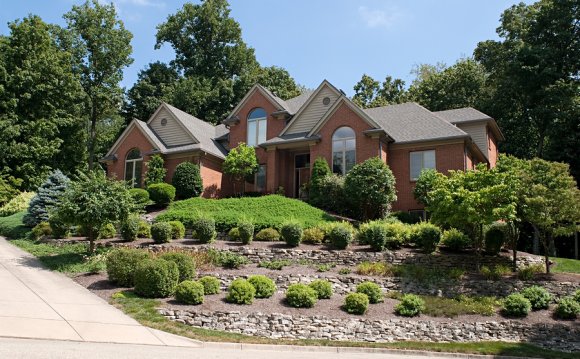
BHG: There are so many styles of landscaping - contemporary, traditional, cottage, to name a few. If you're learning how to landscape and want to pick your style, are there any common elements?
Carloftis: Yes. If you step back and look at the yards that appeal to you, they likely have a good mix of all the various plant types: evergreen and deciduous trees, perennials, annuals, vines, and shrubs with four-season interest. You don't want your house to look bare in the winter, but you'll also notice that the old rules on how to landscape - only green out front and no flowers - are out. Nowadays you can do whatever you want.
BHG: That might be what is overwhelming: You can do whatever you want. How should gardeners break down their outside spaces when they are figuring out how to landscape?
Carloftis: There are a couple of things to remember when starting to landscape. First, you need to create a focal point; everything else will work around it. Trees are a good place to start. Go to a nursery and look at specimen trees. You can create a focal point with shrubbery, too. At the same time, consider your neighbors and focus your efforts on your front yard. You don't want to be the one house that brings down the look of the neighborhood.
BHG: After a homeowner has created a focal point, what comes next on the landscape list?
Carloftis: Make sure your landscape helps to create an entrance to your home. That's where guests first look and it's a common courtesy to highlight it. That may mean shrubs or simple foundation plantings, which got their name in the 1950s when they were used to hide ugly concrete-block foundations. I like to line a walkway to create a tunnel that visually feels like you are going somewhere and gives direction. It's really pleasing.
BHG: You mentioned that well-done yards are a good mix of all types of plants, but a lot of people get intimidated by combining color. What's a solution for them on how to landscape?
Carloftis: You can keep it really simple by just using shades of green. That always looks good, elegant, and tasteful. You don't have to get too fancy. And there are simple ways to add color, too. Irises are great for color and texture, and anyone can grow easy-to-care-for Knock Out roses, which turn into shrubs.
BHG: What typically is the difference between front and back landscapes?
Carloftis: The front landscape is usually about working off the architecture of the house and generally should be finished first. But once you get to the back, it's a more personal space. Think of it as a room or series of rooms - it's where you entertain, raise your children, grill out. So break it down if it's big and think about that one little patio. Create some plantings around it. Then once you master that area, move onto different areas and treat everything else as a room or rooms.
BHG: If you just can't - for time or money reasons - dive into big landscaping projects, what's a relatively fuss-free way to add color and visual interest?
Carloftis: Containers. They are multifunctional and really easy. Put one on the side of your door, along the driveway, even where you get out of the car.
BHG: What if you just feel like you don't have time - or interest - to learn how to landscape?
Carloftis: I always tell people that it's OK to live for a little while in your house and figure out how you want to use it. And as with everything, start out small. If you're not into gardening and don't like it, you might want to hire someone to do it. You'll be happier, and you may save money by not making costly mistakes.















